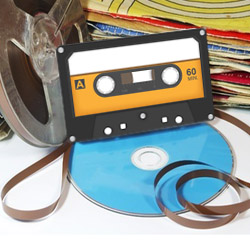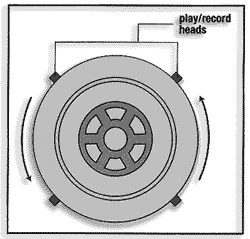
The general rule in a studio is to clean the heads before each session’s use and to de-magnetize them once a month. Any installation with a regular technician should try to stick to that.
However, for typical contractor installs, a bi-monthly cleaning and a 6-month demagnetizing will make a dramatic difference. This practice can be added to normal visits with the client, and it can put you back in touch with clients you haven’t seen in a while.
When cleaning tape heads, the most common mistake is using rubbing alcohol. Rubbing alcohol usually contains negatively charged ions, which transfer a negative charge to the tape head.
Instead, use tape-head cleaner. It breaks up the junk on the head without leaving a charge. It also evaporates fast without leaving calcium deposits on the head, enabling the machine to be used right away.
When de-magnetizing a tape head, turn the de-magnetizer on at least 6 feet from the machine, and move in slowly. Put the tip of the de-magnetizer just over the tape head.
Once the tip gets within about a half-inch or quarter-inch from the head, the demagnetizer will pull hard toward the tape head. Don’t let the demagnetizer touch the head! Rather, slowly wave it around over the head. Then slowly move away and turn the demagnetizer off at least 6 feet from the machine.
Cleaning and demagnetizing should take about five minutes. A regular schedule will keep the machine sounding noticeably closer to the factory specs over time.
Cleaning Rotating Video Heads
Helical scan heads, commonly found in VTRs, DATs and tape-based digital audio multitracks, also benefit from clean heads. The decks will read the tape with a lower error rate, better maintaining the integrity of the video images and sound.
The common mistake here is to use the cleaning tapes found in the local discount store. The problem with these is they are abrasive. Their rough edges scrape the tape heads as they move across them. While OK in an emergency, they should not be used for regular maintenance. The heads should be cleaned manually.

To clean the heads on these machines, the unit will have to be opened up. (Check with the manufacturer to make sure this won’t void your warranty.) The rotating drum is plainly visible inside.
To clean the head, take a lint-free cloth and dab it with 90 percent (or higher) denatured alcohol or isopropyl alcohol. Lightly press the cloth against the drum, slowly turning the head in a counter-clockwise direction with the other hand.
It’s good practice to start and stop turning the drum where your finger isn’t resting on the head. While the unit is open, quickly clean the other rollers as well.
Cleaning the heads this way obviously requires more effort, so this realistically only needs to be done once a year, or two or three times per year on decks in heavy use. Cleaning the heads manually certainly pays off.
On some machines, it will extend the life span of the heads by 200 to 250 percent over using the abrasive cleaning tapes. Since the heads are typically the most expensive part in the deck, that’s worth the annual cleaning.
